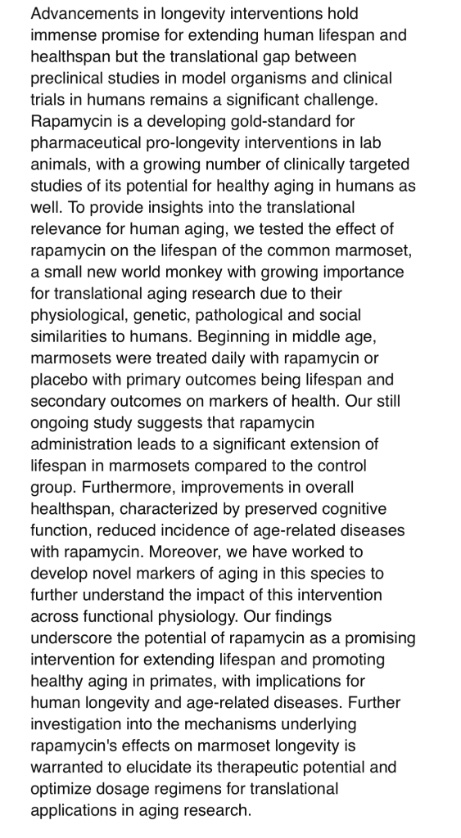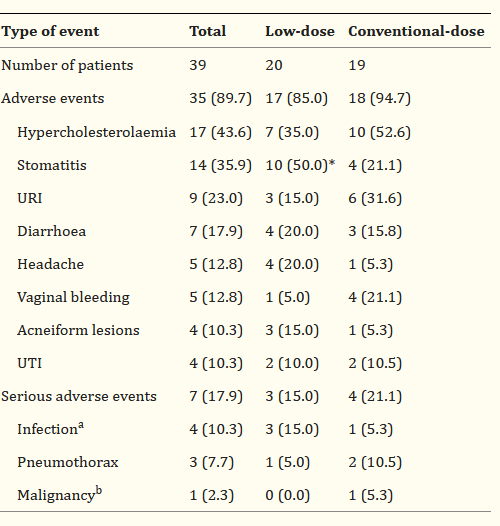It won’t end up being a high yearly expense at all, just make sure you have your funeral pre-paid if you select any of these options … all will be incompatible with life. Please … nobody do this.
You’ll be out at a T1/2 of 65 hours and on even the 10 mg - will have levels probably of 80-100 ng/mL … nothing is going to work well with that would be my guess.
10 Likes
No luck on the presentation still being available to view.
From David Barzilai:
I’ve had a personal correspondence with Adam regarding his talk (which streamed during the event but is no longer available via the portal). Given the preliminary nature of the data, it’s not yet ready for more specifics to be posted on my channel beyond the abstract image below. I will keep you and my other aging biology followers up-to-date, as always, following prepublication standards and the author’s wishes.
Here is the full abstract of the talk:

4 Likes
It wouldn’t be equivalent to taking it daily for humans. Marmosets most certainly metabolize rapamycin faster than humans and will therefore have a shorter half life. So taking it daily for the marmosets might be similar to taking it perhaps 1-2 times weekly for humans.
3 Likes
Fully agreed. I’ve recently had a bacterial infection that may or may not have been related to my high dose of rapamycin. That’s why I’m much more hesitant to use it for now until the relevant facts emerge.
5€ taurine had a similar effect in mice and monkeys and is a lot safer too.
3 Likes
I guess I’m much more worried about malignancy and viral infections and optimizing my T cell immunity. This is an argument for Rapamycin. I’m not worried about bacterial infections - because for me, they are obvious to spot and easy to treat. People get into trouble when they don’t recognize the presence of one … or more often, foolishly just watch it get worse day after day, hoping (hope is not a good strategy in fighting bacterial infections, I’d mention) that it’ll get better.
I get exposed to multiple viruses daily in the ER where I still work 3 days per week. Don’t wear masks, and deliberately get exposed. If I do catch something, I might get 24 hours of minimal symptoms, and probably only catch something once every 6 weeks despite all the exposures. I hope my T cells are doing as good of a job surveilling for cancers as they are at taking care of viruses.
8 Likes
However, what if Rapamycin is like many other drugs such as SGLT2Is, Telmisartan, statins and others where a minimum threshold provides most of the benefits? Even if you double, triple, or quadruple the dose, the law of diminishing returns kicks in and you don’t get all that much more bang for the dose.
At 1-3 mg, people don’t notice much in terms of side effects and I would argue this is too low. 6 mg has more effects but might be too low for some. 9-15 mg has even more side effects and probably an effective range. Above 20 mg, we run the risk of MTOR2 inhibition. If we are experiencing side effects from a med, shouldn’t we also be reaping the benefits?
A higher dose may be better, but I’d say you probably get a lot of the benefits of Rapamycin on a 9+ mg a week dosage. Unfortunately, we don’t have any studies for this. We really need something like that. (Although we all are running our own N=1 experiment currently.  )
)
For the record, I am doing 12-14 mg weekly (4 mg + GFJ) and I have one heck of a canker sore. 
8 Likes
A_User
#90
Unless it’s something you’ve had problems with in the past, it is very likely related. I would also be worried about getting shingles if you aren’t vaccinated, or other similar diseases when taking rapamycin, which probably increase risk for Alzheimer’s.
I wonder if there is a case for a ultra low dose rapamycin, like 1 mg or 2 mg a week. Do we even know the dose-efficacy curve? All the other medications are highly effective long below the dosage used in practice, like for statins, ezetimibe, SGLT2i, PCSK9i, etc.
Maybe something like, take 1 or 2 mg a week for a few years, then increase to 3 mg if no sign of increase in infection, etc.
3 Likes
Help! Is it safe to continue Rapamycin with gallstones? I’m a fit health optimizer practicing all the things for years who unexpectedly ended up in the ER with acute cholecystitis due to gallstones… I got away without surgery this first time but barely. Does anyone on here know if it’s safe to resume rapa to lower inflamation? Thank you!
PBJ
#92
I have been thinking about a dosing protocol I have not seen discussed anywhere. Something like a 6mg initial dose, followed by say 2-3mg timed to maintain a target serum level for a longer duration. This could avoid the unwanted side effects of high single dosages, while theoretically getting more benefit time.
1 Like
It’s tricky - but I think the best approach is a sufficient single dose sufficient to get a 20-24 hour level of ~4.5-5 ng/mL … that will usually get around 50 hours or so of levels >3 ng/mL - if you want to buy into the hypothesis that this is what we want to target for. Adding additional doses will then complicate the curve a bit and for most people dosing to this extent, doesn’t really seem to have more side effects.
I’d suggest that for most people, unless you weigh 30 kgs, the 6 mg will not get to 3 ng/mL at 20 hours. You’ll be well below that level, almost certainly.
Given that we don’t have proof of outcomes in humans, my approach to dosing has evolved a little, but on the best theories I’ve come up with, it would seem sensible to have a dose sufficient and proven to have a biological effect consistent with mTOR inhibition, which I think the 3 ng/mL would seem to be the minimum threshold.
On the safety side of things, having constant mTOR inhibition will put one at risk of immunosuppression and a whole host of other adverse outcomes. So making sure there is a good % of time in recovery seems sensible.
For my patients with significant risk of neurocognitive disease or already with early disease, there is a constellation of items I pursue, but going with higher rapa doses, with longer dosing intervals is one of the items some patients choose to pursue - typically getting an initial 20 hr level of ~6.5-7 and then being on a 14 day dosing interval.
No medical advice meant or given - just describing my approach.
11 Likes
Hi DrFraser. If you have time could you elaborate and describe some more of your approaches for patients with significant risk of neurocognitive disease who may also be taking rapamycin?
1 Like
PBJ
#95
Thanks for responding. Your 50 hours or so of levels >3 ng/mL sounds logical.
@DrFrasery. Your rapa plan is surprising to me. I’m curious to know your reaction to my strategy on rapamycin…it is similar to my strategy on stress mgmt and stretching my muscles to get a full range of motion. I want to teach my body to be able to operate in the full range…not be stuck in the mTOR full on (or sympathetic full on) end of the range all the time.
So rapamycin is just a way to get mTOR low artificially once in a while so my body can do it naturally during low stimulus periods.
This might not work in reality but it gives me a mental model that allows me to use rapa at all. I won’t take a big dose all the time or even once a week. I take a big dose (~12mg) every two weeks with no food (besides gfj) to get a high peak and then quick clearance. Then I suffer though the few days of recovery from rapa with the hope that I’m getting a mTOR benefit. So far I am getting some immune system benefits: joint pain, allergies.
I use deep breathing exercises before bed to make my body remember a low sympathetic/ high parasympathetic state. It also helps me sleep well.
I do stretching every morning to let my body feel what a full range of motion feels like. It also feels good.
3 Likes
Joseph - 12 mg w/ GFJ every 14 days is having you do my neurodegenerative plan … you just didn’t know it. That is often going to get you into the 6-8 ng/mL at 20 hrs … probably worth checking. You’ll generally get ~40-45 hrs T1/2 off of a single big dose, and that’ll give you ~4.5 days of levels >3 ng/mL … which is you having 30-35% of the time in mTOR inhibition - gets you a dosing frequency recommended of 14 days.
I have a patient doing exactly that dose and frequency with GFJ, I think he is ~170 lbs.
@BeatTheOdds In regard to what I do with neurocognitive decline risk (or early disease) it’s pretty detailed and I’m going through this in a series on the blogs on my website. The Don’t Lose Your Mind one outlines it … but I need to add Lithium to the list … so that will make 10 items on the pharmacotherapy side of things … then there is the whole domain of nutrition, exercise, sleep, stress, etc.
8 Likes
Thanks for the info. I hope it is helping me in the way you say…. I also still cling to my hope of helping my body remember how to perform better (be “younger”). Perhaps it is just via repairing my immune system so it can do its job as before.
2 Likes
I agree with you. This has been my approach also, that is, I think it’s good to aim for a plasma level that will definitely inhibit mTOR for at least 1-2 days and inhibit it quite a lot for at least the first day. This would mean aiming for the low end of transplant patient levels (above 3 ng/mL or so) at the end of the second day, but higher on the first day. The dosing interval would then be adjusted to avoid side effects. For some that might be once a week, for others once every two weeks or more.
2 Likes
Neo
#100
Very helpful to see this thinking. Sorry if I missed it, but can you discuss more where the target of
is coming from?
A_User
#101

Low-dose:
Subjects treated with sirolimus, who had mean blood trough levels maintained < 5 ng/mL, were classified as the low-dose sirolimus group.
35% rate of hypercholestrolaemia.
https://www.ncbi.nlm.nih.gov/pmc/articles/PMC6236936/
1 Like
Neo
#102
Hi @Olafurpall , do you have any thoughts on to what extent Acarbose and perhaps 17a estradiol can help offset negatives around mTORC2i in high dose rapa contexts?
Neo
#103
How do we put that in context? What is that rate in other people sick enough to need an organ transplant and on other immunosuppressants?
Anyway, seems that it is something that can be well measured and then calibrated for - as long as one does take it seriously.